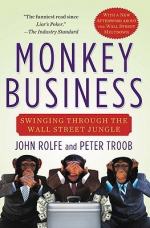
|
| Name: _________________________ | Period: ___________________ |
This test consists of 15 multiple choice questions and 5 short answer questions.
Multiple Choice Questions
1. When were some of the only times new an old associates and old associates speak their true feelings concerning DLJ?
(a) After a bonding experience in the country.
(b) After doing drugs.
(c) When they go on an outing to the Empire State Building.
(d) When they were all very drunk.
2. What do most business schools indoctrinate into their grads?
(a) How to be a good investment banker.
(b) Having ethical business practices.
(c) How to party and have a good time.
(d) Importance of a "money" culture.
3. If a deal is brokered between a managing director and a client, what did this mean for associates and analysts?
(a) A very large work load.
(b) Celebrating and drinking.
(c) Company outings.
(d) Kissing up to the managing director with praise.
4. What do investment banks no longer put up front to help the new business?
(a) Their lawyers opinions.
(b) Their stock portfolios.
(c) Their own money.
(d) Investor names.
5. What did the winning investment bank distribute to potential buyers to get a sale?
(a) A pitch book.
(b) A deed of sale.
(c) A graph booklet.
(d) A prospectus.
6. How did the associates justify the value of a company?
(a) Discussing the value with lawyers.
(b) Doing research of the company that is for sale.
(c) Whatever creative methods he needed to use.
(d) Math equations.
7. How did Troob and Rolfe eventually become fast friends?
(a) Troob helped Rolfe with a difficult task at work.
(b) Troob bailed Rolfe out of an embarrassing situation.
(c) Rolfe and Troob are very much alike.
(d) Troob rescued Rolfe from being attacked at the office.
8. What is discounted cash flow analysis?
(a) An invented way of undervaluing a company.
(b) The means of discounting items that are for sale.
(c) Profit margins are used to pump up the future value of a company.
(d) A way to count money.
9. How much did Rolfe know about investment banking, prior to starting as a summer associate?
(a) A lot because his father was an "I-Banker."
(b) He was a summer associate, so he knew a lot about the industry.
(c) He knew very little because he had not worked for an investment bank.
(d) He knew a lot because all his friends were in banking.
10. What were all nine summer associates looking forward to come fall?
(a) Going back to school.
(b) A chance to impress the bosses.
(c) A permanent offer.
(d) A big summer bonus.
11. What was exciting about the DLJ training in August?
(a) The associates were exposed to expense accounts and lavish lifestyles.
(b) The associates learned more about the company.
(c) The grads were traveled around the world.
(d) The graduates got to see New York City.
12. Who was Les Newton?
(a) A pit bull in meeting with clients.
(b) A gator who never lets a pitch dies.
(c) A whiz kid with a lavish lifestyle.
(d) A mean managing director.
13. What did many recruiters like to do while traveling?
(a) Clubbing.
(b) Went to expensive dinners.
(c) Relax and got massages.
(d) Played golf.
14. How did summer associates get full time jobs?
(a) Did jobs in addition to investment banking.
(b) Ran errands for supervisors.
(c) They worked very hard.
(d) By kissing a lot of butts of superiors.
15. What unlikely venue did recruiters take Troob and Rolfe?
(a) A barbeque restaurant.
(b) A strip club.
(c) A wine tasting.
(d) A toy store.
Short Answer Questions
1. Who acts extremely rude and perverse on a social night out?
2. In theory, what were analysts supposed to provide?
3. What kind of firm was the investment bank that Rolfe and Troob were to work for?
4. Depending on the size of the deal that the investment bank brokered, what fluctuated?
5. The personal accounts of the interview process by both Troob and Rolfe were filled with ______ and ______.
|
This section contains 653 words (approx. 3 pages at 300 words per page) |

|




